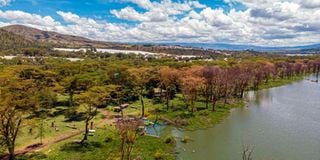A return to the Fisherman’s Camp

An aerial view of Fisherman’s Camp.
Last weekend I had the opportunity to revisit one of Kenya’s classic camping spots — Fisherman’s Camp. A friend fancied a night out of town for his birthday, and chose Fisherman’s with little hesitation. I hadn’t camped on the shores of Lake Naivasha for many years, and I was keen to return.
I left Nairobi early on Saturday afternoon, anticipating a snarl-up along the stretch of highway under construction before the turn-off at Limuru. The road was still a mess, but also surprisingly quiet. It wasn’t long before I was passing the rippled slopes of Mount Longonot, and a swollen Lake Naivasha came into view.
The lake’s southern shores have changed considerably since I first explored them in the 90s. Today, more polythene greenhouses reflect the sunshine, and new restaurants, petrol stations and hotels line the tarmacked Moi South Lake Road. But there are still patches of fairly unspoilt acacia woodland, and as I neared Fisherman’s Camp, a giraffe craned its neck over a low wall to browse by the side of the road.
I was pleased to see that Fisherman’s had retained some natural charm, too. Although a lot of its green space has been swallowed by the lake, there are still plenty of attractive camping spots beneath tall, twisting acacias. I wandered over to the shore as I waited for my friends to arrive, and admired the views across the lake from a makeshift jetty.
Submerged
Naivasha is derived from the Maa word for rough water, enaiposha, but on this clear evening the water was as smooth as glass. The lake was flanked to the northeast by the long, purple peaks of the Aberdares, and to the northwest by the green hills of the Eburu Forest.
A pair of Egyptian geese honked and hissed on a bed of spongy hyacinth nearby, and a fish eagle called distinctively from the top of a drowned acacia. It was a quintessential Naivasha scene, and a reminder of why Fisherman’s is so enduringly popular.
One of the camp’s safari guides, Simon, offered to show me around. He said that half of the property had been submerged since the lake started rising in February 2020, but that the water was now receding.
An electric fence was installed to stop hippos from venturing into the camping zone on the far right of the property. So now, after dark, campers are ferried by car across hippo territory between the campsite and the restaurant.
Wooden structures
Simon also showed me a couple of relatively new bandas towards the back of the camping area. He told me that one of these angular, wooden structures sleeps 10 people, and the other sleeps four. The older bandas are still available, too, including the more secluded Kasuku Cottage.
The rest of my group arrived and we set up camp within a cluster of acacias near the new bandas. It being Labour Day, the camp was absolutely packed, and there was a lively buzz about the place. I enjoyed a pizza from the restaurant for dinner, and we sat around our campfire late into the night.
We eventually crawled into our tents around 1am, but the parties around us continued long after that. I vaguely recall being woken up at 4am by a heated debate about cricket bowling speeds.
Thankfully, a fish eagle provided a much more natural alarm call a few hours later, and I somehow mustered the energy for a run before breakfast. I turned right on the main road and struggled up the steep stretch towards Elsamere. But it was worth it for the view — the sky was as clear as the evening before, and the low sun shimmered in the shallows.
As Naivasha develops, it’s good to know that one of its earliest campsites is still as popular as ever. For those hoping for a more peaceful experience, I’d suggest visiting on a weekday.
For rates and more information, head to www.fishermanscamp.com, or call 0726 870590.





